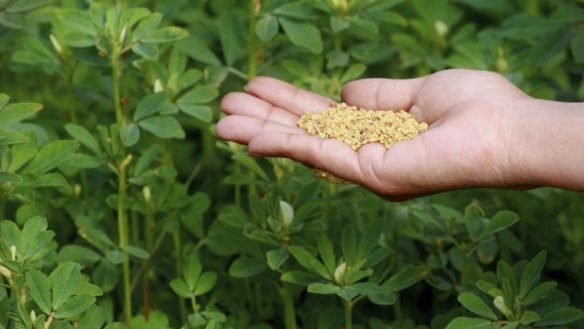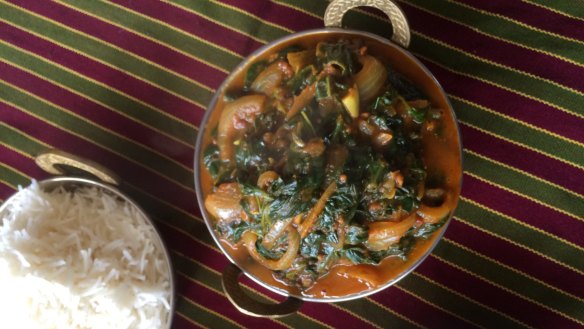Bryan Martin: How to use fresh fenugreek to make a vegetarian tamarind curry

Sometimes just one ingredient will spark an idea for a shopping list and a recipe. From that point I'll be charting a course that will generally take a few hours, and I'll get way more food than I need, but put together this dish, I must.
This week it's a couple of bunches of fresh methi (fenugreek) I found at the markets.
Even though I love the idea of these regional food markets, I just can't get up early enough to catch the best of them every week so I have to wing it as to where I might go hunting for food.
There's this hierarchy of places where I might end up, with Costco last on the list.
The markets at Belconnen and Fyshwick are definitely my second choice. They don't have that real market feel any more, but you can find some decent stuff there. I tend to look at the greengrocers that don't look like a supermarket aisle, have a good range of organic produce and stock weird stuff.
It was at Belconnen I found these methi bunches. When fresh, this is such a good ingredient, subtle, aromatic, and delicate. You can get the dried version but other than smelling a lot like cannabis, it tends to add just a dusty taste to a curry. These fresh herbs are something else.
Clearly, a curry was on my mind and a vegetarian one at that, so I grabbed a huge amount of mixed greens – spinach, watercress and chicory, along with mint, curry leaf, ginger and some little green chillies. All this while trying to recollect a recipe from those long-gone, vegetarian days.
In the very impressionable post-teen years, I came across a Hare Krishna book on Vedic cooking in Kings Cross. Obviously I was in the wrong place for someone so impressionable but this book has stayed with me all these years. When this vegetarian urge to nourish my soul, body and mind overcomes me, I will find it lurking at the back of my cookbook cabinet to enlighten me with absolute knowledge once again.
This book puts forward a pretty good argument that we shouldn't hunt and eat meat. There is obvious evidence, like our lack of claws and sharp teeth to factors like our alkaline saliva and lower strength stomach acid. Both are apparently less suited to breaking down animal flesh than the high acid systems that predators like lions and tigers have.
Vedic cooking is one of the few that doesn't use onions or garlic so is heavily reliant on spices to give the dish richness. And when we talk about spices we mean fresh spice. Unlike sourdough "mothers", great wine and men like me, spices don't get better with age. That little bottle of garam masala you have had since little Johnnie Howard was in power isn't going to cut it for a dish that is based on trade spices. The reason your friends with a subcontinental heritage make great curries isn't just because they have grown up on this food. Through constant use, they keep their spices fresh.
Keeping whole seeds, and roasting and grinding just what you need, is key to this dish having any level of authenticity. Any mixture of leafy greens will work, I tend to cut the stems off and just use the leaf, as there is more bitterness in the stems. This is especially so for fenugreek so only use the leaves if you can find the fresh version but dried fenugreek will still give you a nice curry. Tamarind is an acidifying agent, it has a meatiness too so adds to the richness though lemon juice will work if you are without.
Finally, serving a lemony raita of mint and yoghurt will set off the dishes splendidly. Phew, I've got that off my chest, now what's next ... jabuticaba – what the hell is that?

Fresh fenugreek, greens and tamarind curry
3 tbsp ghee
2 tbsp brown mustard seeds
1 tbsp fenugreek seeds
1 sprig curry leaves
2 tbsp ginger, chopped finely
2 tbsp garam masala (see recipe below)
1 tsp ground turmeric
1 tsp chilli powder
½ cup tomato puree
1 bunch spinach, chopped
1 bunch watercress, tough stems removed
1 bunch curly endive, leaves chopped
2 bunches fresh fenugreek, leaves only
¼ cup tamarind water, see note
2 small green chillies, chopped
salt
Mint raita to serve, see recipe below
Heat the ghee and start frying the mustard and fenugreek seeds. Take your time so you don't burn the fenugreek, in particular. Once they start popping, add the curry leaves and ginger, cook this for a minute or two and add the garam masala, turmeric and chilli powder, stir through, adding the tomato puree and a cup of water.
Cook for five minutes then stir in the greens, cover and simmer for 15 minutes. Add the fenugreek leaves, tamarind and chilli and cook for another five minutes. You can use extra water if this gets too thick. Season with salt and serve with mint raita and rice
Garam masala
1 tbsp ground coriander seed
1 tsp cumin seed
1 tsp cardamom seed
½ tsp black peppercorns
¼ cinnamon quill, broken up
2 cloves
Fry the seeds in a hot pan until fragrant, grind to a fine powder.
Tamarind
60g dried tamarind
½ cup water
Break up the tamarind and bring to a simmer in the water. Cook for 10 minutes and strain out as much liquid as you can.
Mint raita
1 cup unsweetened yoghurt
12 mint leaves, chopped
1 lemon
salt
Finely grate the lemon zest into yoghurt, and add the juice from that lemon along with the mint, season.
The best recipes from Australia's leading chefs straight to your inbox.
Sign up